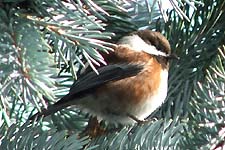Local Wildlife
Black-capped Chickadee

Scientific Name: Parus atricapillus
Audio: Listen Now
Audio Source: Cornell Lab of Ornithology
Addt'l Info: Univ. of Michigan
The chickadee belongs to a group of birds known as titmice. The characteristic black crown, black throat, and white cheeks make this little bird stand out, especially on those drab winter days. In addition to its signature markings, is has a greenish gray back, dark wings and tail, and white markings on its wings.
Chickadees can be found in both deciduous and coniferous forests. In the summer months, willow, cottonwood, alder, and birch trees are favorite locations. But in winter, the cones of various pine and fir trees are of greater interest. Year-round residents of Sunriver, these small birds can be seen no matter the time or the weather. Listen for their distinctive call, "Chicka-dee-dee-dee".
The chickadee is considered omnivorous--that is, it eats both animals and plants. During the winter season about half its diet will be comprised of various insects such as catapillars and spiders and the other half of plant matter such as seeds and berries. During the summer season, this ratio changes to about 90% insects and 10% berries and seeds.
Much of a chickadee's life is spent searching for food. Interestingly, they rarely eat at the same place where they located the food. Instead, they will seek shelter to eat, helping to shield them from possible predators.
